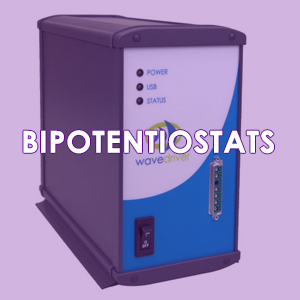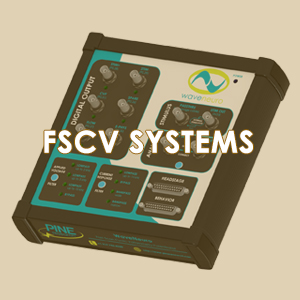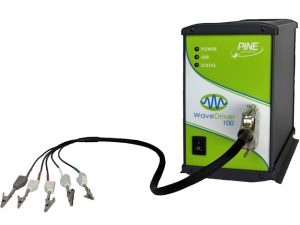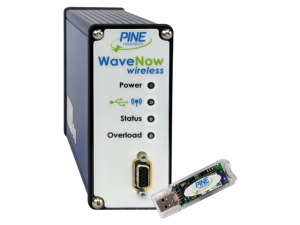You’ve Got Choices
Pine Research offers a variety of potentiostat and bipotentiostat systems suitable for use in research, instructional, and industrial laboratories. Designed and built by a talented staff of engineers, chemists, and technicians, Pine Research has over 30 years of experience building potentiostats. With a classic understanding of analog electronics meshed with a modern take on digital conversion, we strive to design a system that is built with quality, free of gimmicks or undisclosed filtering, and supported by our highly attentive customer and technical support. Potentiostat form factors include standard benchtop models and portable units small enough to easily fit into a laptop bag, a coat pocket, or the ante-chamber of a glove box.
WAVEDRIVER SERIES
These benchtop instruments are the more advanced products of the Pine potentiostat line. The WaveDriver potentiostats feature a USB interface, a fully functional potentiostat/galvanostat, and is controlled through AfterMath instrument control and data analysis software. This is one of the most feature-packed potentiostats available on the market for under $10,000. Multi-disciplinary scientists choose the WaveDriver as their electrochemical system of choice.
WaveDriver 100
This benchtop potentiostat/galvanostat system is capable of performing Electrochemical Impedance Spectroscopy (EIS) along with a wide variety of DC electroanalytical techniques. The WaveDriver 100 is ideal for everyday EIS experiments, cyclic voltammetry, differential pulse and square wave voltammetry, and hydrodynamic methods such as Rotating Disk Electrode (RDE) and Rotating Cylinder Electrode (RCE) voltammetry. The WaveDriver 100 features additional filters and a faster processor than the WaveNow series single-channel potentiostats.
WaveDriver 200
Like the WaveDriver 100, the WaveDriver 200 is capable of performing Electrochemical Impedance Spectroscopy (EIS) along with a wide variety of single and dual electrode DC electroanalytical techniques. The WaveDriver 200 is a true integrated bipotentiostat, capable of controlling one or two working electrodes operating in the same electrochemical cell along with a counter and reference electrode, making this instrument ideal for Rotating Ring-Disk Electrode (RRDE) voltammetry.
WAVENOW SERIES
These portable instruments offer a convenient alternative to traditional stationary benchtop instruments. The newest addition to our WaveNow potentiostat series lets you enjoy the freedom of controlling your electrochemical experiments wirelessly! The WaveNow Wireless Potentiostat/Galvanostat gives you portability and access to remote lab spaces without creating a cabling problem. This is the perfect potentiostat for use in a glovebox – simply put the entire instrument into the glovebox along with your electrochemical cell and conduct your air-sensitive voltammetry experiments from any nearby computer.
WaveNow Wireless
The WaveNow Wireless potentiostat/galvanostat is an all-purpose system for everyday use. Even though it’s a little bit larger than your smartphone, it is quite powerful, robust and capable to perform all classical electrochemical methods. The WaveNow current resolution ranges from 100 nA to 100 mA and its voltage range is +/- 4 V. Customers use the WaveNow in teaching environments, as well as in research and industrial laboratories.
WaveNowxv
The WaveNowXV shares the same capabilities as the WaveNow but includes an extended voltage range of +/- 10 V. Customers that perform battery research often select this model for the larger voltage window. The WaveNowXV is a great option for teaching, research and industry.
WaveNano
The WaveNano is the low current version of the WaveNow. It features a current resolution from 100 pA up to 1 mA. The low current option is often selected by users that work in the field of biosensors, and other low-current electrochemical areas. As with any low-current measurement, additional care to minimize stray environmental noise will be necessary to routinely measure small current signals above noise.







